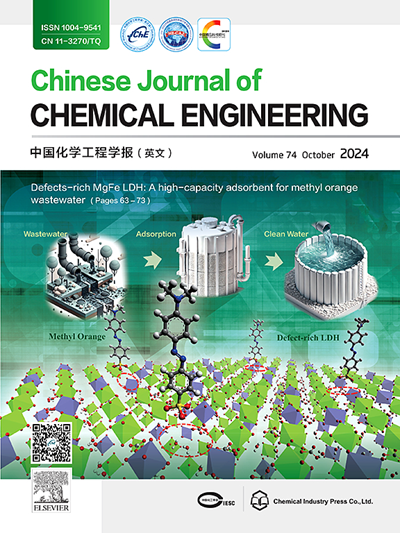Separation and recovery of V/W/Na from waste SCR catalyst leaching solution using membrane electrolysis – Ion morphology pretreatment solvent extraction-stripping method
IF 3.7
3区 工程技术
Q2 ENGINEERING, CHEMICAL
引用次数: 0
Abstract
In this study, a cleaner method for separation and recovery of V/W/Na in waste Selective catalytic reduction (SCR) catalyst alkaline leaching solution was proposed. The method involved membrane electrolysis followed by ion morphology pretreatment and solvent extraction. An acidic V(V)/W(VI) solution was obtained using the membrane electrolysis method without adding any other chemical reagents. In addition, Na was recovered in the form of NaOH by product, avoiding the generation of Na containing wastewater. The electrolysis parameters were investigated, the lowest power consumption of 3063 kW·h·t−1 NaOH was obtained at a current density of 125 A·m−2and an initial NaOH concentration of 2 mol·L−1. After electrolysis, oxalic acid was added to the acidic V/W containing solution, converting V(V) negative ion to V(IV) positive ion. Since W(VI) ion state remained in negative form, the generation of heteropolyacid ions (WxVyOzn−) was prevented. It was found that under the condition of oxalic acid addition/theoretical consumption 1.2 and reaction temperature 75 °C, 100% V(V) was converted to V(IV). Using 10% N263 + 10% n-octanol+80% sulfonated kerosene as extractant, the highest W(VI)/V(IV) separation coefficient of 7559.76 was obtained at pH = 1.8, O:A ratio = 1:1 and extraction time 15 min. With 2 mol·L−1 NaOH as stripping reagent, the W stripping efficiency reached 98.50% at O:A ratio = 2:1 after 4-stages of stripping. The enrichment of V remained in the solution was realized using P204 as extractant and 20% (mass) H2SO4 as stripping reagent. The parameters of extraction/stripping process were investigated, using 10% P204 + 10% TBP+80% sulfonated kerosene as extractant, the V extraction efficiency reached 97.50% at O:A ratio = 1:2 after 4 stages of extraction. Using 20% H2SO4 as the stripping reagent, the V stripping efficiency was 98.30% at an O:A ratio of 4:1 after five stages of stripping. After the entire process, a high-purity VOSO4 and Na2WO4 product solutions were obtained with V/W recovery efficiency 95.84%/98.50%, separately. This study examined a more effective and cleaner method for separating V/W/Na in Na2WO4/NaVO3 solution, which may serve as a reference for the separation and recovery of V/W/Na in waste SCR catalysts.

膜电解-离子形态预处理溶剂萃取-汽提法分离回收SCR催化剂浸出废液中的V/W/Na
本研究提出了一种更清洁的方法来分离和回收废物选择性催化还原(SCR)催化剂碱浸液中的V/W/Na。方法采用膜电解、离子形态预处理和溶剂萃取。在不添加任何其他化学试剂的情况下,采用膜电解法得到酸性V(V)/W(VI)溶液。此外,钠以NaOH副产物的形式被回收,避免了含钠废水的产生。结果表明,在电流密度为125 a·m−2、NaOH初始浓度为2 mol·L−1的条件下,电解的最低功耗为3063 kW·h·t−1。电解后,将草酸加入酸性含V/W溶液中,使V(V)负离子转化为V(IV)正离子。由于W(VI)离子状态保持在负离子状态,阻止了杂多酸离子(wxvyzn−)的生成。结果表明,在草酸添加量/理论用量1.2、反应温度75℃的条件下,100%的V(V)转化为V(IV)。以10% N263 + 10%正辛醇+80%磺化煤油为萃取剂,在pH = 1.8、O:A比为1:1、萃取时间为15 min的条件下,W(VI)/V(IV)分离系数最高,为7559.76。以2 mol·L−1 NaOH为萃取剂,在O:A比为2:1的条件下,经过4段萃取,W的萃取效率可达98.50%。以P204为萃取剂,20%(质量)H2SO4为溶出剂,实现了溶液中残留V的富集。以10% P204 + 10% TBP+80%磺化煤油为萃取剂,在0∶A = 1:2的条件下,经过4次萃取,V萃取率达到97.50%。以20% H2SO4为溶出剂,经过5级溶出,在0∶4∶1的条件下,V溶出效率为98.30%。经过整个过程,得到了高纯度的VOSO4和Na2WO4产品溶液,V/W回收率分别为95.84%和98.50%。本研究探索了一种更有效、更清洁的分离Na2WO4/NaVO3溶液中V/W/Na的方法,可为SCR废催化剂中V/W/Na的分离和回收提供参考。
本文章由计算机程序翻译,如有差异,请以英文原文为准。
求助全文
约1分钟内获得全文
求助全文
来源期刊

Chinese Journal of Chemical Engineering
工程技术-工程:化工
CiteScore
6.60
自引率
5.30%
发文量
4309
审稿时长
31 days
期刊介绍:
The Chinese Journal of Chemical Engineering (Monthly, started in 1982) is the official journal of the Chemical Industry and Engineering Society of China and published by the Chemical Industry Press Co. Ltd. The aim of the journal is to develop the international exchange of scientific and technical information in the field of chemical engineering. It publishes original research papers that cover the major advancements and achievements in chemical engineering in China as well as some articles from overseas contributors.
The topics of journal include chemical engineering, chemical technology, biochemical engineering, energy and environmental engineering and other relevant fields. Papers are published on the basis of their relevance to theoretical research, practical application or potential uses in the industry as Research Papers, Communications, Reviews and Perspectives. Prominent domestic and overseas chemical experts and scholars have been invited to form an International Advisory Board and the Editorial Committee. It enjoys recognition among Chinese academia and industry as a reliable source of information of what is going on in chemical engineering research, both domestic and abroad.
 求助内容:
求助内容: 应助结果提醒方式:
应助结果提醒方式:


